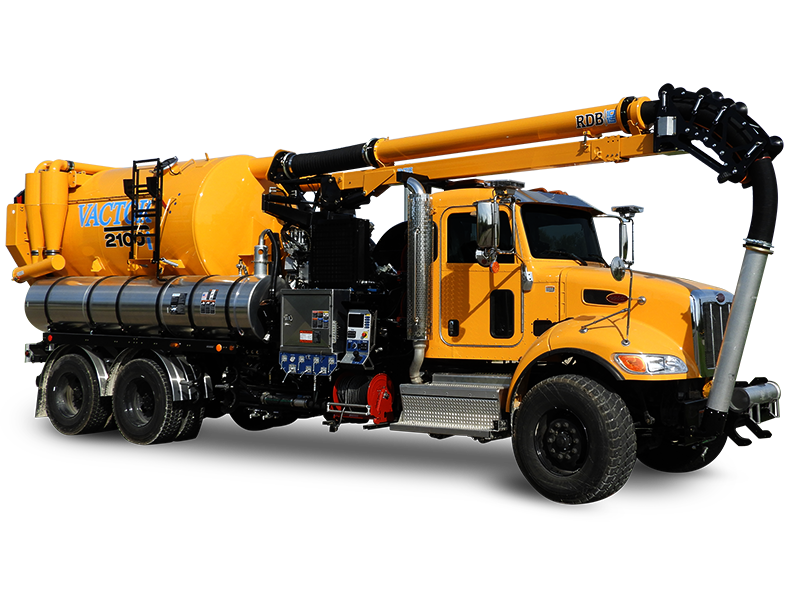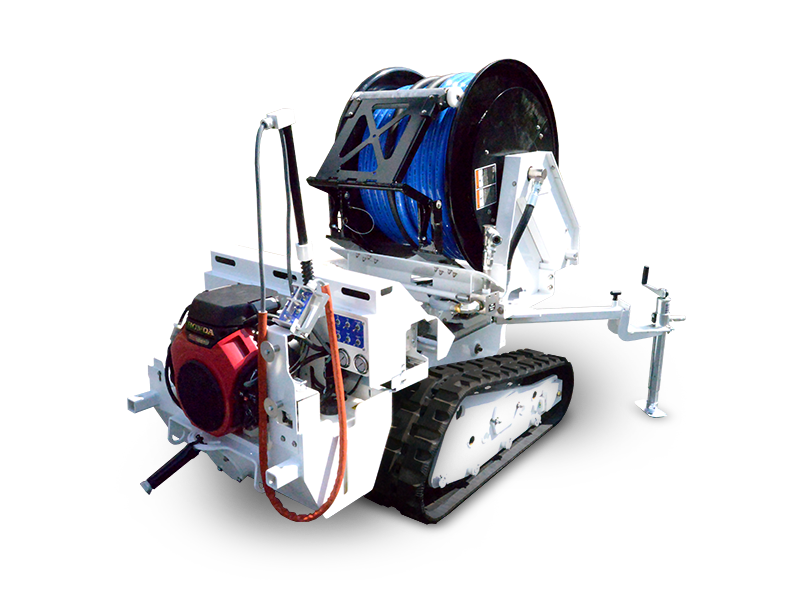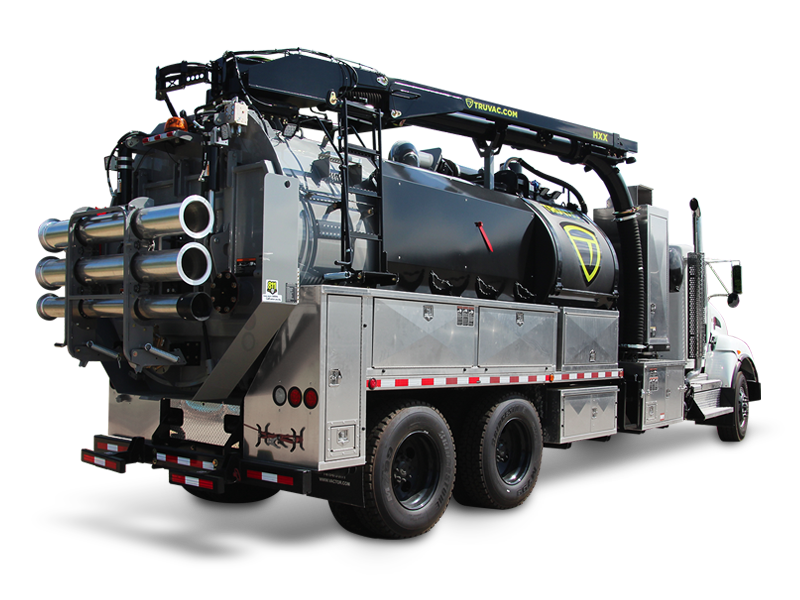Rise of the Fatberg: Secret of the Ooze
by Vactor Team, on Jun 20, 2024 1:47:31 PM
Beneath the hustle and bustle of city life, a sinister presence is growing in the shadows, gathering power from our discarded waste. These colossal monstrosities are not creatures of myth but very real and problematic: they are fatbergs. The partition of sewers and the rebirth of waste congeal to create an enemy of urban plumbing. In this article, we dive into the murky world of fatbergs, dissecting what these masses consist of, how they emerge, and the role our everyday items play in their growth.
The unsuspecting pour of cooking oil down the sink and the innocent flush of a 'flushable' wipe contribute to an underground catastrophe. This section discusses how household habits like disposing of grease and using wet wipes inadvertently set the stage for sewer blockages and overflows, highlighting the gap between common practices and their unintended consequences. By dissecting the journey of these seemingly harmless actions, we reveal a path that clogs the arteries of our cities.
Public action and awareness are beacons of hope in combating these sewer system clogs. The closing segment introduces strategies aimed at stirring society's consciousness about fatbergs and highlights potential resolutions to keep our underground tunnels clear. From the grimy depths, we unearth stories of record-breaking fatbergs, reflecting on what they signal about our waste management and what it will take to prevent their return.
What is a Fatberg?

Fatbergs, a portmanteau of "fat" and "iceberg," are monstrous masses found lurking in the underbelly of urban sewer systems. A fatberg is an unsightly agglomeration of household and personal items that should never make their way into the sewer system:
These elements combine to create a solid, concrete-like mass that can grow over the course of years to daunting proportions, obstructing pipes and leading to substantial sewage overflows.
The awareness of fatbergs and their impact has grown significantly, particularly with the media spotlight on increasingly large specimens. These discoveries serve as stark reminders of the challenges posed to modern sewer systems by current waste disposal habits. To tackle this growing issue, cities and public works departments launched public awareness campaigns to emphasize the importance of proper garbage disposal as a key contributor to preventing the formation of fatbergs.
Dawn of the Fatberg (Fatberg Begins)
The Impact of Fat, Oil, and Grease (FOG)
The story of a fatberg's life begins with the introduction of fats, oils, and grease (FOG) into the sewer system. Cooking oil and grease are not only kitchen staples; they serve as the foul nutrients for growing fatbergs. When we rinse these substances off our pans and plates, we are effectively mama-birding them right into the mouths of fatberg larvae. When we rinse these substances off our pans and plates, they cool, solidify, and coalesce with other waste items, such as wet wipes, wrappers, and hygiene products that were inappropriately flushed. The interaction between the fat and waste materials, sometimes with the inclusion of calcium, can lead to saponification—the transformation of fat into a soap-like substance—which contributes to the stabilizing structure of a fatberg, and ultimately, a formidable obstruction.
These monoliths are often found where sewer flow becomes turbulent, as the rough surfaces in these areas make ideal catch points for accumulating oils and debris as they coagulate, curdle, and congeal.

This binds the sewer system, causing blockages and, in some instances, significant sewer overflows that wreak havoc on the environment. The infamous 1.2 million-gallon overflow in Baltimore stands as a grim testament to the severe repercussions of such events.
The challenge of preventing and managing fatbergs involves increased vigilance about what enters our drains, with a strong emphasis on the three P's: pee, poop, and toilet paper—are the only things that should be flushed down the toilet to maintain a healthy and obstruction-free sewer system.
Globally, cities like London, New York, and others across Australia and Canada attest to the pervasive challenge of fatbergs. Their experiences illuminate the need for better cooking oil and grease disposal practices, which, if unchecked, can culminate in overwhelming clean-up operations for water companies. By understanding the pivotal role that cooking oil and grease play in the formation of fatbergs, communities can take proactive steps to mitigate these greasy monsters' growth.
The very structure of our drainage systems is under threat due to the ubiquitous practice of washing these fatty substances down kitchen sinks. To combat this growing menace, the implementation of traps designed to capture fat, oil, and grease (FOG) before entering the sewers is one practical measure. The consequences of inaction are dire – with blockages, possible sewage backup into properties, and substantial clean-up costs. Prevention, through proper disposal and public education, is necessary to protect the intricate networks that whisk away our wastewater.
The Contribution of Wet Wipes and Flushable Wipes
Despite being labeled as "flushable," wet wipes and so-called flushable wipes are among the main contributors to the burgeoning fatberg crisis. Unlike toilet paper that disintegrates quickly in water, these wipes often fail to break down, subsequently becoming ensnared in the sewer systems. They excel at trapping grease and solidifying with other non-biodegradable materials, further compounding the fatberg problem. Experts, including Kimberly Worsham of FLUSH (Facilitated Learning for Universal Sanitation and Hygiene), have identified wet wipes as key players in the formation of fatbergs. Once they become soaked, their sturdiness and resistance to disintegration contribute to fatbergs' immense sizes and the disastrous impediments they cause in sewer flow.
Paper Towels and their Impact
While seemingly innocuous, paper towels are a deceptively common villain in the narrative of sewer blockages. Their sturdy construction, built to absorb and clean up spills effectively, turns disadvantageous when disposed of via the toilet. Paper towels are not designed to disintegrate in water like toilet paper. Instead, they maintain their form, becoming a stubborn blockage in wastewater pipes. The widespread habit of flushing them can have dire consequences, contributing to the formation of fatbergs when combined with grease, cooking oil, and other waste products. Educating the public to dispose of paper towels in a trash receptacle remains paramount in safeguarding our sewer systems from the avoidable perils of improper waste disposal, thereby averting sewage overflows and environmental concerns.
Human Waste and its Role in Fatberg Formation

In the labyrinth of our city's sewers, human waste mixes with cooking oil, wet wipes, and various non-biodegradable materials to engender formidable blockages known as fatbergs. These insidious masses evolve from a confluence of our daily waste products, binding to create a formidable obstacle within the wastewater conduits. Over time, these blockages grow in size and severity, often remaining undetected until they induce tangible sewer system complications.
Fatberg, Right Ahead
The odyssey of dismantling a fatberg is a tale of modern-day urban archaeology, harkening back to a problem encountered even in Roman times. Initially coined to describe beachside fat clusters, "fatberg" found its way into the lexicon in 2008, symbolizing the subterranean monsters residing in our sewers. Much like the rock-like masses of antiquity that required manual cleaning, today's fatbergs consist of a similar medley of congealed fats, cooking oil, and non-biodegradable flotsam. The battle against them is relentless, waging for weeks at a time and requiring a barrage of attacks. Key to these endeavors is the use of specialized machinery, which may include high-pressure water jets from a Vactor truck, to break apart these gargantuan blockages. However, the steadfast nature of fatbergs often requires workers to also employ more basic tools like shovels and pickaxes, feverishly excavating to restore functionality to the beleaguered sewer systems. The Herculean efforts required to dismantle these giants from the bowels of our cities carry with them not only a financial burden but also health risks to the brave workers tasked with their removal. The release of gasses during their extraction can pose formidable hazards, evidencing the broader societal implications of what we discard. Consequently, these fatberg removal costs, which can spiral into hundreds of thousands of dollars, trickle down, affecting taxpayers with increased sewage rates and heightening public health concerns (such as antibiotic-resistant bacteria).
The Consequences of Fatbergs in Sewer Systems
The immediate repercussion is the clogging of inner drain pipes, which precipitates backups and flooding of wastewater into homes and businesses. Such events pose not only a public health risk but also inflict property damage and incur substantial costs in cleanup efforts.
 image courtesy of NYC Water https://www.flickr.com/photos/nycwater/46424509654/in/album-72157676644452507
image courtesy of NYC Water https://www.flickr.com/photos/nycwater/46424509654/in/album-72157676644452507
The presence of fatbergs is not trivial; it represents a severe strain on municipal resources and infrastructure. For instance, New York City's Department of Environmental Protection dedicates an astounding $19 million yearly to combat these greasy monstrosities, money that could be allocated to other pressing infrastructure needs. Similarly, cities with antiquated sewer systems, such as London, which boasts pipes dating back to the Victorian Era, are ill-equipped to manage not only the volume of modern wastewater but also the additional challenge posed by fatbergs. The consequences ripple through the system, requiring intensive labor and heavy machinery to extract these blockages, often at the price of disrupting streets and diverting funding from proactive measures to emergency responses.
Damage to Sewer Infrastructure

Fatbergs pose a costly and destructive force to sewer infrastructure. Sewer systems across the United States, particularly in older cities with aging pipes, are at high risk. The inadequate design of these historic pipes fails to accommodate the burgeoning production of waste and the unforgiving nature of fatbergs. Moreover, products that contribute to this issue, especially wipes—misleadingly branded as flushable—inflict US utilities with over $441 million in annual expenses due to increased operational costs for maintenance and repairs.
Particularly vast blockages can take weeks to dislodge and escalate the necessity for aggressive and costly extraction methods. These methods often result in impassable roads, dug-up streets, budgetary constraints, and, unavoidably, the transference of financial burdens onto residents through elevated sewer and water rates.
The Biggest Fatbergs in History

The tales of urban nightmares lurking beneath our cities have been superseded by the reality of fatbergs. Among all these putrid logjams, some have climbed from the depths to take their places in history due to their gargantuan size and the complexities involved in their excavation. The Whitechapel Fatberg, discovered in 2017 in the heart of London, stands out as a monumental example. Weighing a colossal 130 tons and extending an impressive 250 meters (820 feet) along the sewer tunnel—matching the length of two football fields—it epitomized the alarming scale these blockages could reach. A sample of this abominable creation was on display at the Museum of London.
Notable Fatbergs Across the Globe
Other infamous fatbergs share the Whitechapel Fatberg's place in history. For instance, in the London neighborhood of Shepherd's Bush, 2014 marked the discovery of a blockage as sizable as a Boeing 747 aircraft, composed of the typical culprits such as wet wipes, waste fat, and sprinkled with peculiar additions like wood planks and tennis balls. Across the globe, Melbourne, Australia, also battled a significant fatberg menace in 2014, facing tremendous costs in its removal. In the United States, Macomb County, Michigan battled a 100ft long x 11ft wide x 6ft high fatberg obstruction in Sept. 2018, exactly a year after the Whitechapel record-setter. These instances underscore the global prevalence of fatbergs. People sheltering-in-place during the Covid19 pandemic, combined with toilet paper shortages brought on by panic-buying, resulted in a surge of wet wipes and other non-flushable products being deposited into sewer systems. Cities like Melbourne saw blockages increase by as much as 30%. Gisborne removed two fatbergs from the same location, only two years apart. Consumer behavior had changed, and our critical infrastructure was struggling to keep up.
Reducing Fatberg Formation
Cutting off the problem at its source is critical in the battle against fatbergs.
Several strategies have been identified to prevent these blockages from forming in the first place. For instance, in the United States, many commercial businesses have adopted the installation of grease traps as a standard practice. These devices are central to the effort to intercept oils and fats before they enter the sewer systems.
At home, the practice of pouring coffee grounds, fat, oils, or food remnants down the drain can have accumulating consequences. These substances are primary contributors to fatberg development and should be disposed of properly in trash receptacles. Additionally, while garbage disposals offer convenience, they also add to the strain on wastewater treatment facilities. Moderation in their use is key, reducing the volume of material that could potentially feed the formation of a fatberg.
City regulations play a part, too. By enforcing the sizing and maintenance of grease traps, especially in high-output establishments like restaurants, municipalities can curtail the flow of fats, oils, and grease (FOG) into the sewage system, weakening the foundations upon which fatbergs heave themselves.
Regular Maintenance of Sewer Systems
To protect the literal underbelly of our cities, the maintenance of sewer systems is vital. Recognizing that fatbergs can quietly grow to monumental proportions, utility crews must patrol and inspect sewer lines as part of regular sewer maintenance. The use of high-powered water jets, saws, and pickaxes by workers clearly illustrates the intensive labor required for the removal of these encrusted blobs.
Public awareness campaigns are also a part of regular maintenance programs, aiming to enlighten the public about the consequences of improper disposal of waste. Educational initiatives serve as a preventive measure by informing citizens about which items can wreak havoc on sewage systems.
Implementing Stricter Regulations on Disposables
The response to fatbergs has also seen the implementation of regulatory measures on disposable items. Such regulations aim to minimize fatberg occurrences by controlling what can and cannot be discarded into the sewer systems. Items like wet wipes, feminine products, diapers, and even seemingly innocuous band-aids can become key components of a fatberg.
Awareness campaigns and regulations, including the requirement for grease interceptors in restaurants and food processing businesses, help mitigate the risk. Moreover, efforts to educate consumers on the real impact of so-called "flushable" wipes have been critical since these are notorious for their contribution to fatbergs.
In a significant move to address disposables globally, Australia and New Zealand established a product labeling standard in 2022 to categorically determine a product's flushability. In response, Kleenex® AU adapted their line of flushable wipes to meet the new standard. Through stricter regulations product labeling, the hope is to steer consumer behavior away from contributing to these blockages. Through proactive and responsible citizenry, we can stem the lifeline of fatberg sustenance altogether, thus ensuring the sustainability and effectiveness of our sewer systems.
Undoubtedly, a multi-pronged approach—combining education, regulation, and infrastructure maintenance—is necessary to raze these festering brutes. Every action plays a critical role in protecting our environment, our freedom, and keeping our sewers flowing freely.













